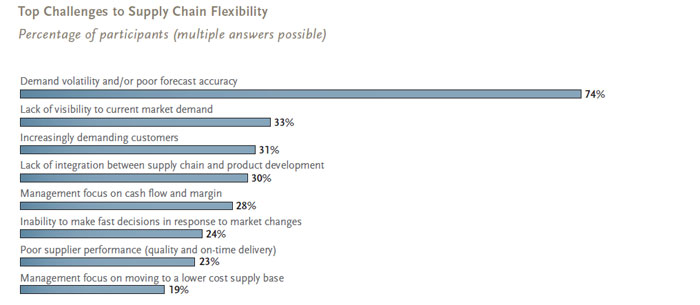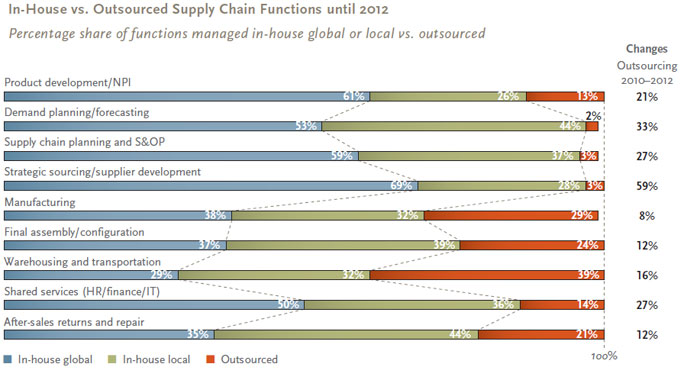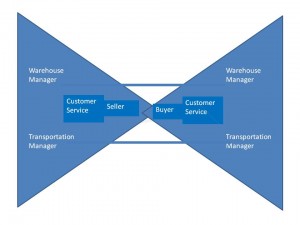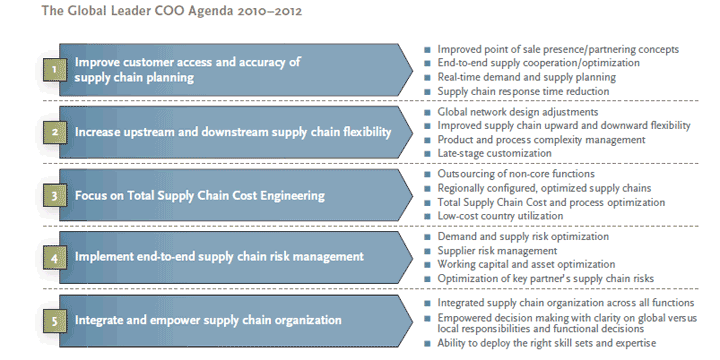In a recent post entitled The Importance of Identifying Trends, I discussed an article that asserted that companies that identify and adjust to trends the fastest are the ones most likely to survive and thrive. Recently, members of the editorial staff at Supply Chain Digest put together their list of the top five challenges facing supply chain executives [“The Five Challenges of Today’s Global Supply Chains,” 12 August 2010]. Their challenges emerge from trends they see occurring in the supply chain sector. They write:
“A recent survey of some 350 supply chain executives from across the globe by the consultants at PRTM identified five key supply chain challenges for the next few years. Successful management of those challenges, the resulting report says, will be central to a company’s ability to capture benefit from an eventual economic upturn.”
Before discussing the identified trends and their associated challenges, did you notice the lack of optimism concerning the economy displayed by the magazine’s editorial staff? I suspect their lack of enthusiasm comes from the fact that they are primarily focused on the sluggish U.S. economy. Elsewhere things are already looking brighter. “Danish shipper and port operator A.P. Moeller-Maersk A/S (MAERSK-B.KO) and Dubai-based ports operator DP World (DPW.DIF) [recently] reported higher profits and said they expect the improvement to continue.” [“Shippers, Ports See Profits Rise As Trade Picks Up,” by Ian Edmondson and Tahani Karrar-Lewsley, Wall Street Journal, 18 August 2010]. Edmondson and Karrar-Lewsley report that “trade has started to rebound this year with both sea and air operators reporting a strong increase in volumes.” Returning to the challenges facing supply chain executives, the first trend is a bit of a misnomer since it deals with uncertainty. The term “trend” normally is attached to a series of events or activities that have both direction and velocity while uncertainty has neither of those qualities.
“Trend 1:Supply Chain Volatility and Uncertainty Have Permanently Increased: Market transparency and greater price sensitivity have led to lower customer loyalty. Product commoditization reduces true differentiation in both the consumer and business-to-business (B2B) environments. Increasing volatility is a major issue. The [PRTM] report says that some 75% of respondents consider demand and supply volatility and poor forecast accuracy to be the biggest supply chain roadblocks they currently face. (See chart below [click to enlarge].) The increased commoditization of products plays a key role here, even beyond the demand volatility associated with the recession. With an increasing ability and willingness of customers to find alternative supply sources, B2B customer demand can move up or down dramatically and rapidly. ‘Customer loyalty has significantly decreased in the past 12 months,’ said one industrial manufacturer participating in the study. What are companies doing to manage this volatility? ‘Companies are focusing primarily on deepening collaboration with key customers to reduce unanticipated changes in demand,’ the report says. ‘Half of participants plan to implement joint “real-time” planning with their key customers by 2012, and nearly half plan to develop processes for improved demand sensing—that is, understanding the market rate of demand in real time, rather than having to wait for after-the-fact reporting.'”
To learn more about the importance of business forecasting, read my post entitled Demand Driven Supply Chains. In that post, noted supply chain analyst Lora Cecere identifies some the trends she believes will affect the supply chain sector. She agrees with the editors at Supply Chain Digest that data is growing in importance. In a more recent post, however, Cecere takes umbrage with those who use the term “collaboration” when they really mean better data sharing [“Time to Broaden the Knot on your Bow Tie?” Supply Chain Shaman, 17 August 2010]. She writes:
“I have been writing about supply chain collaboration for the last fifteen years. The term is bandied about. Supply chain strategy documents drip with it. Conference presentations are ladened with the concept. They include phrases like collaborate with your trading partners, build collaborative networks, implement collaborative technologies, and collaborate to build value. … Can you imagine how unpopular I am, when I give clients the feedback that ‘true supply chain [collaboration] can only really happen when you have a lasting win-win value proposition.’ My goal of this blog: stop the madness. Reset expectations. Stop fooling yourself. What most people call collaboration is really data sharing. Collaboration can only really happen when you have a lasting win-win value proposition; and in this changing world of power structures, constraints, and demand volatility, this is harder than ever.”
The second trend identified by the editorial staff at Supply Chain Digest recognizes the fact that most growth in the future is going to come from emerging market economies.
“Trend 2: Securing Growth Requires Truly Global Customer and Supplier Networks: Future market growth depends on international customers and customized products. Increased supply chain globalization and complexity need to be managed effectively. Most survey participants expect that future business growth will come primarily from new international customers and/or products that are customized to meet customer needs. ‘As a result, more than 85% of companies expect the complexity of their supply chains to grow significantly by 2012,’ the report says. Interestingly, the survey found that while most companies expected growing complexity in the number and location of customers and in SKU counts and product variants, the majority expects a decrease in the number of manufacturing locations, primarily due to outsourcing, and in the number of suppliers they work with. ‘Regionally configured supply chains will be the key to success,’ the report suggests. ‘These supply chains serve regional customers according to their requirements, while bundling supply chain partners, manufacturing facilities, and distribution centers as much as is economically possible.'”
I agree with the above observations on two counts. First, although they don’t explicitly state where international customers are going to be found, most analysts agree that new customers are primarily living in emerging market countries. To learn more about emerging market economies, read my posts entitled Emerging Markets — Room to Grow, Emerging Market Nations Continue to Fare Better than Others, Update on Emerging Markets: Asia Leads Global Recovery, and The Decade of Emerging Markets. Second, I have repeatedly predicted that within globalization’s broader framework regionalization is going to play an increasingly important role. In fact, regionalization is the focus of the next identified trend.
“Trend 3: Market Dynamics Demand Regional, Cost-Optimized Supply Chain Configurations: Customer requirements and competitors necessitate regionally tailored supply chains and product offerings. End-to-end supply chain cost optimization will be critical. Survey respondents expect gross margins to increase over the next two years, not from better pricing power but – as is always the case it seems – from further reductions in supply chain costs. Improved globalization of the supply chain and still more outsourcing were viewed as the main two levers to reduce supply chain costs. The chart below is a good one, showing what supply chain related functions are done internally, either at a local or global level, or outsourced, as well as the percent change expected in outsourcing between 2010 and 2012. [Click to enlarge.] But companies with large expectations for savings from outsourcing need to be careful – ‘The majority of respondents report that, while they have achieved substantial material and labor cost reductions through outsourcing, most have yet to see significant reductions in process or management costs,’ the report notes. Leading companies understand the impact of these hidden costs and are taking aggressive steps to identify and manage them, PRTM says.”
In a post I wrote earlier this year about agricultural trade and the tendency of countries to hoard food when times get tough, I asserted: “There is a saner middle ground between full-on globalization and outright hoarding; and I suspect it will alleviate many of the current concerns. That middle ground will be an increase of regionalization within globalization. Such a course makes sense because it shortens supply lines (and transportation costs), encourages better relations between neighbors, fosters sensible economic clusters, yet maintains the connectivity necessary for the global economy to expand.” The PRTM report only strengthens my views on the subject of regionalization. The next trend involves risk management.
“Trend 4: Risk Management Involves the End-to-End Supply Chain: Risk and opportunity management should span the entire supply chain—from demand planning to expansion of manufacturing capacity—and should include the supply chains of key partners. The recession was a tough time for supply management, mostly around managing supplier financial risk. Some of those pressures are ebbing, but now many companies are looking to improve their supply chain performance by shifting more risk on to the backs of suppliers – and that means a new set of risk management challenges. ‘Leading companies are taking an end-to-end approach in managing risk at each node of the supply chain. To keep the supply chain as lean as possible, they are taking a more active role in demand planning, which ensures that they order only the amount of materials needed to fill firm orders,’ the report says. It says leading companies are also limiting the complexity of products that receive late-stage customization, and mitigating inventory-related risks by shifting the responsibility for holding inventory to their suppliers.”
To learn more about this topic, read my post entitled Supply Chain Risk Management. As I noted in that post, risk management is not a science. Even the best-made contingency plans and most thoughtful predictions can’t account for every eventuality (e.g., volcanic eruptions in Iceland). What a good risk management strategy provides a company is choice. Because executives have explored a number of possibilities, they are much more aware of alternative courses of action. The last predicament in which a company wants to find itself is one in which it has no choices. The final trend is about integration.
“Trend 5: Existing Supply Chain Organizations Are Not Truly Integrated and Empowered: The supply chain organization needs to be treated as a single integrated organization. In order to be effective, significant improvements require support across all supply chain functions. We’ve been at this supply chain game for more than two decades, but most companies still have a long way to go to integrate their supply chains, the report says. Only by improving that level of integration while empowering supply chain managers to make decisions can the first four challenges be effectively met. The challenge is to make decisions that optimize the total supply chain, not one function or node – something most companies realize, but still have a hard time achieving. In 2010, approximately 50% of the companies will manage supply chain planning and S&OP on a globally integrated level, in contrast with 60% of companies projected for 2012, according to the study. More and more companies of course are appointing a chief supply chain officer (CSCO) and at least have a single executive responsible for the end-to-end supply chain. But that is just one step in building a truly integrated supply chain. A continued focus on finding and retaining top supply chain talent is another. The supply chain organization and its capabilities need to be seen as a ‘single resource’ to the enterprise, the report says.
In Lora Cecere’s post mentioned above, she talks about how difficult it is to achieve the kind of integration and collaboration recommended by the PRTM report. She writes:
“So, what does it take to have true collaboration? The key is to broaden the knot in your bowtie, align goals and develop deep cross-organizational relationships. While traditional approaches have focused on data sharing or transactional efficiency, the use collaborative technologies allow you to connect people to people across the value chain to build more long-lasting relationships. Consider three tactics:
If you are a Buyer. Put your Money where your Mouth is: If you are a buyer, tie scorecards to buying decisions through multi-variant bid techniques from companies like Ariba, Emptoris, Oracle and SAP. Reward suppliers for supply chain excellence, contribution to open innovation and cash-to-cash improvements. Tie scorecards to real money and review them monthly.
If you are a Seller. Teach Sales how to Pitch a Winning Menu: While most incentives for sellers are volume based, work with sales to build a menu of options that can reduce costs and improve the trading relationships. Experience shows that this is not the place for dictating policy. It is impossible to implement standardized practices that can be adopted equally by all trading partners. Instead, focus on a menu program where you incent the partner for buying like option A, option B, option C and then reward the trading partner for taking these options through the use of buying incentives. Include tangible items like shipping programs (backhauls, continuous moves, private fleet utilization, etc.) to reduce costs and improve carbon footprint, use of standards, taking new products, quick unloading of shipments, payment schedules, and sharing of downstream data.
Broaden your Bowtie: Conceptually this concept has been around for along time, but it has been difficult to execute. Just too time consuming to connect trading partner warehouse managers, traffic managers, customer service personnel, etc. Not any more. Use social technologies like Lithium and Jive as a core on partner extranets to connect people to people. Complete with pictures, interests, microblogging, instant messaging, and fan pages. Who says that supply chain cannot be more social?”
The Supply Chain Digest article concludes by rhetorically asking, “What is the New Supply Chain Agenda?” It continues:
“Synthesizing this data and insight, the PRTM report suggests the following five supply chain priorities for the coming few years, as shown in the graphic below.”
The biggest trend that emerges from this discussion is that companies are going to continue to squeeze supply chains to keep costs down and profits up. I offer one caveat — companies that trade off too much flexibility to generate more efficiency are setting themselves up for a fall. Rigid supply chains are brittle and can break. Finding the right balance between flexibility and efficiency is not easy. It changes by sector, by product type, and even by season. The more information that is shared throughout the supply chain the easier it is to find the right balance and become more resilient.








